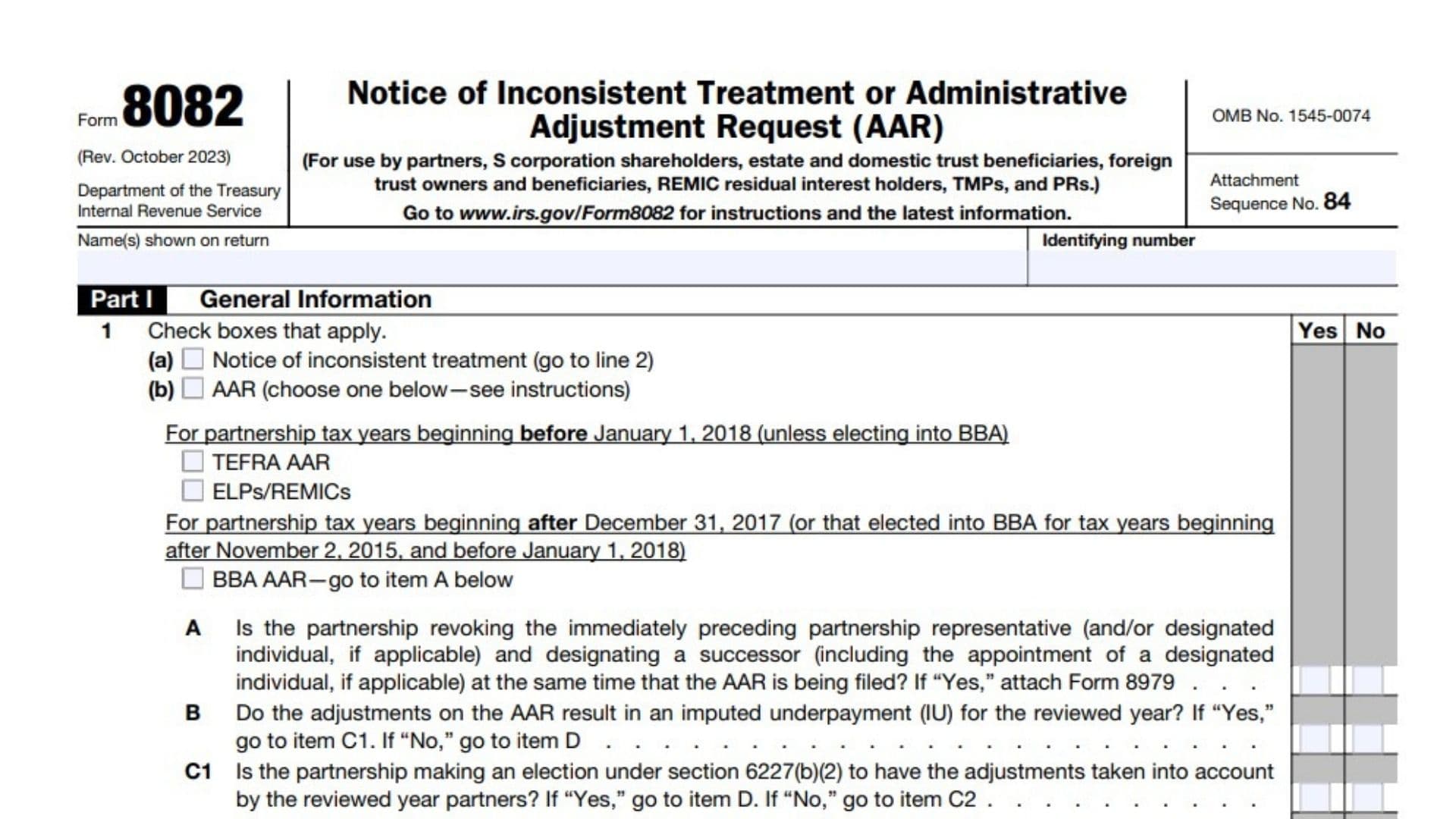IRS Form 8082, titled “Notice of Inconsistent Treatment or Administrative Adjustment Request (AAR),” is used by partners, S corporation shareholders, beneficiaries of estates or trusts, REMIC residual interest holders, and other relevant parties to either (1) notify the IRS of inconsistent tax treatment of partnership or S corporation items or (2) request an administrative adjustment to correct errors reported on previously filed pass-through entity tax returns. Inconsistent treatment means the taxpayer is reporting income, deductions, credits, or other items differently from what the pass-through entity (like a partnership or S corp) reported. This form ensures transparency and shields taxpayers from certain penalties when their returns don’t align with entity reports.
Additionally, Form 8082 is the official document for initiating an AAR, which allows taxpayers to correct prior year reporting mistakes in pass-through returns under both the TEFRA (pre-2018) and BBA (post-2018) partnership audit regimes. The form also addresses imputed underpayments (IUs), elections under IRC Section 6227, and relevant disclosures regarding reviewed-year partner statements. Filing this form accurately is essential to avoid penalties, trigger proper IRS reviews, and correct partner/shareholder-level reporting issues.
How to File Form 8082?
- Attach Form 8082 to your federal tax return (Form 1040, 1041, 1120S, etc.).
- If you’re filing electronically, include it in the electronic return.
- If submitting a paper return, staple the completed Form 8082 behind the main tax return form.
- Submit timely: File by the due date (including extensions) of your tax return for the year affected by the inconsistency or correction.
- Keep a copy for your records.

How to Complete Form 8082?
Top of the Form
- Name(s) shown on return: Enter your full legal name as it appears on your tax return.
- Identifying number: Use your SSN, EIN, or ITIN depending on your filing status.
Part I – General Information
Line 1: Check boxes that apply
- (a) Notice of inconsistent treatment: Check this box if you are reporting an item differently than what’s reported on Schedule K-1 or a similar statement.
- (b) AAR: Check this if you’re filing an Administrative Adjustment Request.
If AAR applies, answer additional sub-items depending on the partnership type and tax year:
For partnerships under BBA (post-2017), complete the following:
- A: If you’re revoking the current partnership representative/designated individual AND appointing a new one, check “Yes” and attach Form 8979.
- B: Do your adjustments create an imputed underpayment (IU) for the reviewed year? Check “Yes” or “No.”
- C1: If “Yes” to B, are you making an election under IRC 6227(b)(2) to push the adjustments to the reviewed-year partners? Check accordingly.
- C2: If “No” to C1, are there any adjustments that do not result in an IU (e.g., net negative)? Respond accordingly.
- D: If required to issue reviewed-year partner statements, the partnership representative must sign and date here under penalty of perjury, affirming that these statements were sent.
- E: If the partnership is applying any modifications to the IU, check “Yes” and attach Form 8980.
Line 2: Identify your pass-through entity type Check only one of the following:
- (a) TEFRA Partnership
- (b) S Corporation
- (c) Estate
- (d) Trust
- (e) REMIC
- (f) BBA Partnership
Line 3: Employer identification number of the pass-through entity Enter the EIN of the entity you received the inconsistent K-1 or equivalent from.
Line 4: Name, address, and ZIP code of the pass-through entity Provide the full legal name and mailing address of the pass-through entity.
Line 5: Internal Revenue Service Center where the entity filed its return List the IRS processing center (e.g., Ogden, UT; Cincinnati, OH) the entity used.
Line 6: Tax year of the pass-through entity Enter the beginning and ending dates of the entity’s tax year: MM/DD/YYYY to MM/DD/YYYY
Line 7: Your tax year Enter your individual tax year that corresponds with the item being reported differently: MM/DD/YYYY to MM/DD/YYYY
Part II – Inconsistent or Administrative Adjustment Request (AAR) Items
Use a new line (8–11) for each item you’re reporting differently or correcting.
| Column | What to Enter |
|---|---|
| (a) | Description of the item (e.g., “Ordinary business income,” “Charitable contributions,” “Depreciation adjustment”). |
| (b) | Check boxes to indicate whether the inconsistency or correction is in the amount of the item and/or its treatment (e.g., as income vs. capital gain). |
| (c) | Amount as reported by the pass-through entity on Schedule K-1, Q, or similar. |
| (d) | The amount you are reporting on your own return. |
| (e) | The difference between (c) and (d). This can be positive or negative. |
👉 Complete as many rows as needed. Attach an extra sheet if there are more than four items.
Part III – Explanations
- Provide a detailed explanation for each Part II line item.
- Begin each explanation with the line number from Part II (e.g., “Line 8”).
- Explain:
- Why the amount/treatment differs
- Legal reasoning or source of authority (e.g., tax code, court cases)
- Calculations for the imputed underpayment (if applicable)
- Any applied modifications
- Be thorough. Clarity here helps prevent audits and penalties.
Final Tips for Completing Form 8082
- Accuracy is key: Inconsistencies or corrections must be clearly documented.
- Attach all supporting schedules: Especially for AARs involving IUs or partner adjustments.
- Include additional forms if required: Form 8979 (representative revocation) and Form 8980 (modifications) when applicable.
- Consult a tax professional if you’re unsure whether your situation qualifies or involves complex partnership audit rules.
